Affiliate links on Android Authority may earn us a commission. Learn more.
Camera shootout: Samsung Galaxy S21 Ultra vs Google Pixel 5
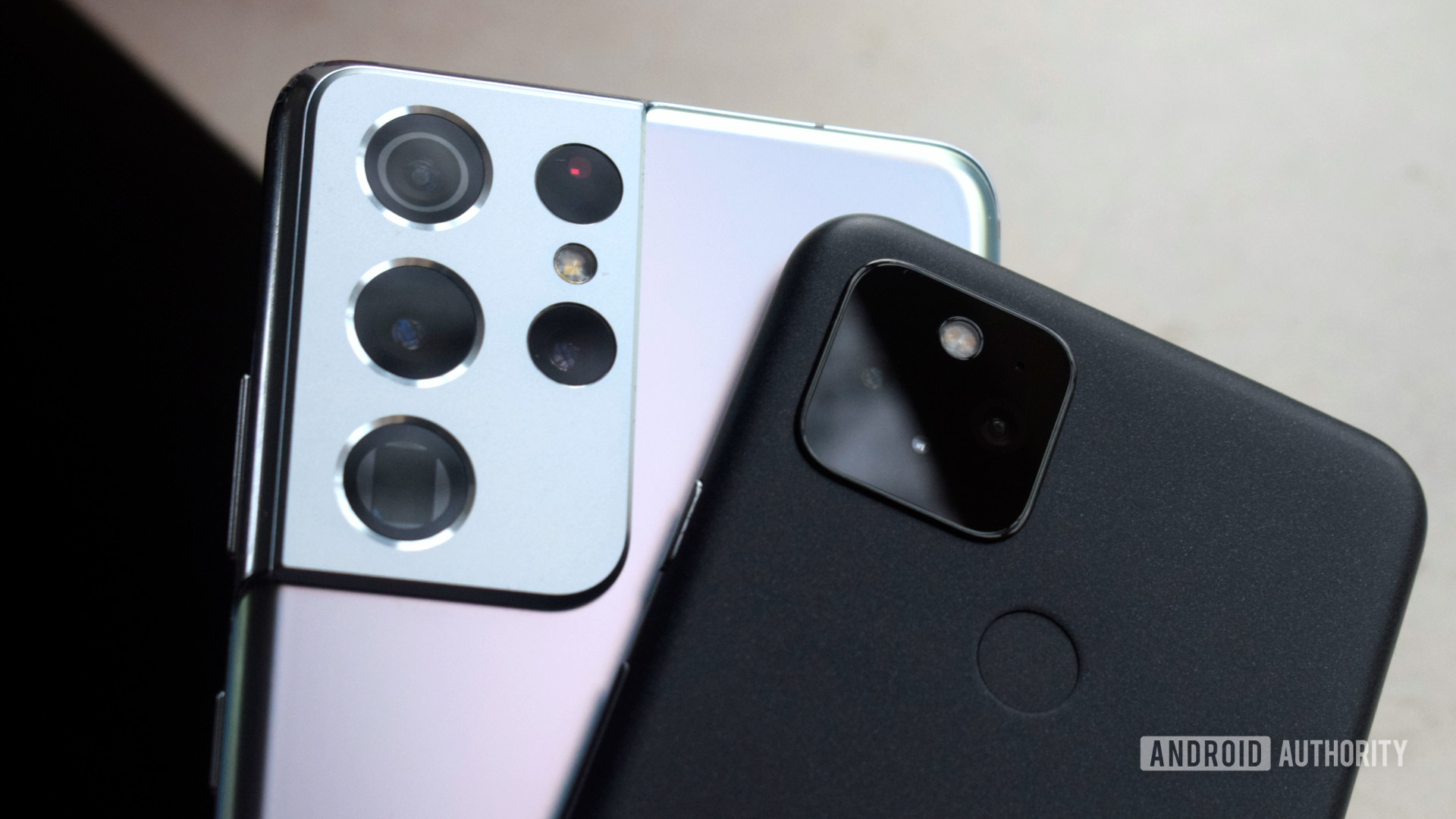
When it comes to big names in the smartphone camera game, Google has one of the better reputations. Its latest Google Pixel 5 flagship may not have all the hardware bells and whistles we see on more expensive smartphones, but it takes some incredible pictures. By contrast, the more recent Samsung Galaxy S21 Ultra comes with one of the most comprehensive camera packages we’ve ever seen in a smartphone and a price tag to match. So how do the two compare in a real-world shootout?
We’re obviously not expecting the $699 Google Pixel 5 to best an ultra-premium flagship that costs almost double its price. But if it can come close to matching the Samsung Galaxy S21 Ultra in more than a handful of the most common shooting scenarios, we’ll chalk it up as a major win for Google’s computational photography prowess.
If you want a closer look at these image samples shot for this comparison, you can view the full-res files here.
Our reviews: Samsung Galaxy S21 Ultra review | Google Pixel 5 review
Samsung Galaxy S21 Ultra vs Google Pixel 5: Camera specs
| Samsung Galaxy S21 Ultra | Google Pixel 5 | |
|---|---|---|
Main Camera | Samsung Galaxy S21 Ultra 108MP (12MP binned) f/1.8 aperture 24mm focal length 1/1.33" sensor PDAF, OIS | Google Pixel 5 12.2MP f/1.7 aperture 27mm focal length 1/2.55" sensor dual pixel PDAF, OIS |
Wide-angle | Samsung Galaxy S21 Ultra 12MP f/2.2 aperture 13mm focal length 1/2.55" sensor dual pixel PDAF | Google Pixel 5 16MP f/2.2 aperture |
Telephoto zoom | Samsung Galaxy S21 Ultra 10MP f/2.4 aperture 70mm focal length 1/3.24" sensor dual pixel PDAF, OIS 3x zoom | Google Pixel 5 |
Periscope zoom | Samsung Galaxy S21 Ultra 10MP f/4.9 aperture 240mm focal length 1/3.24" sensor dual pixel PDAF, OIS 10x zoom | Google Pixel 5 |
Focusing | Samsung Galaxy S21 Ultra Laser AF system | Google Pixel 5 |
Daylight, colors, and exposure
Samsung has a reputation for heavily saturated colors, and the Galaxy S21 Ultra is no exception. The company has dialed its effect back a little this generation. The worst offenses can mostly be circumvented by disabling the Scene Optimizer feature, which tends to go a bit overboard when looking at certain scenes. Still, Samsung’s images pack in some serious color punch.
The Google Pixel 5, on the other hand, sticks very close to realism in pretty much every scenario. However, this can have the drawback of leaving some images and subjects looking a little flat and washed out. See the example below, where the Pixel 5 is a little too dark and doesn’t quite offer the pop and punch you want from a delicious food pic.
Even so, both phones have excellent white balance and exposure in virtually all pictures taken with them, so you can easily tweak colors in your editor of choice should you so desire.
Photography terms explained: ISO, aperture, shutter speed, and more
The same trends apply to outdoor shots too. Colors, exposure, and white balance are all generally great on both phones. However, the Pixel 5 will sometimes underexpose the odd darker image, such as the woodland scene below. It’s tricky shots like this where the Galaxy S21 Ultra’s larger main image sensor helps to capture that bit more light and color, making a noticeable difference.
The bottom line is you won’t be dissatisfied with images from either of these two phones in broad daylight. At least not without peeking closer at the 100% crops. Some benefits are gained from the Galaxy S21 Ultra’s more expensive hardware package, but they’re hardly night and day.
Samsung Galaxy S21 Ultra vs Google Pixel 5: Detail
Like me, you may assume the Samsung Galaxy S21 Ultra has a major advantage in the detail department thanks to its larger 108MP main camera. But to do so does a major disservice to the Google Pixel 5’s computational photography capabilities and overestimates the level of detail that can be pulled from Samsung’s pixel binned camera arrangement.
For starters, the Galaxy S21 Ultra crops appear oversharpened. Either as a result of pixel binning or a post-processing pass. The Pixel 5’s details are much softer and natural-looking. To my eye, the Pixel 5 has seen some notable improvements to detail capture since launching, thanks to a few software patches. There’s still a notable grain in darker corners, but the noise level is now kept much more under control. As a result, detail rivals and occasionally exceed what you’ll get from the Galaxy S21 Ultra in more demanding scenarios.
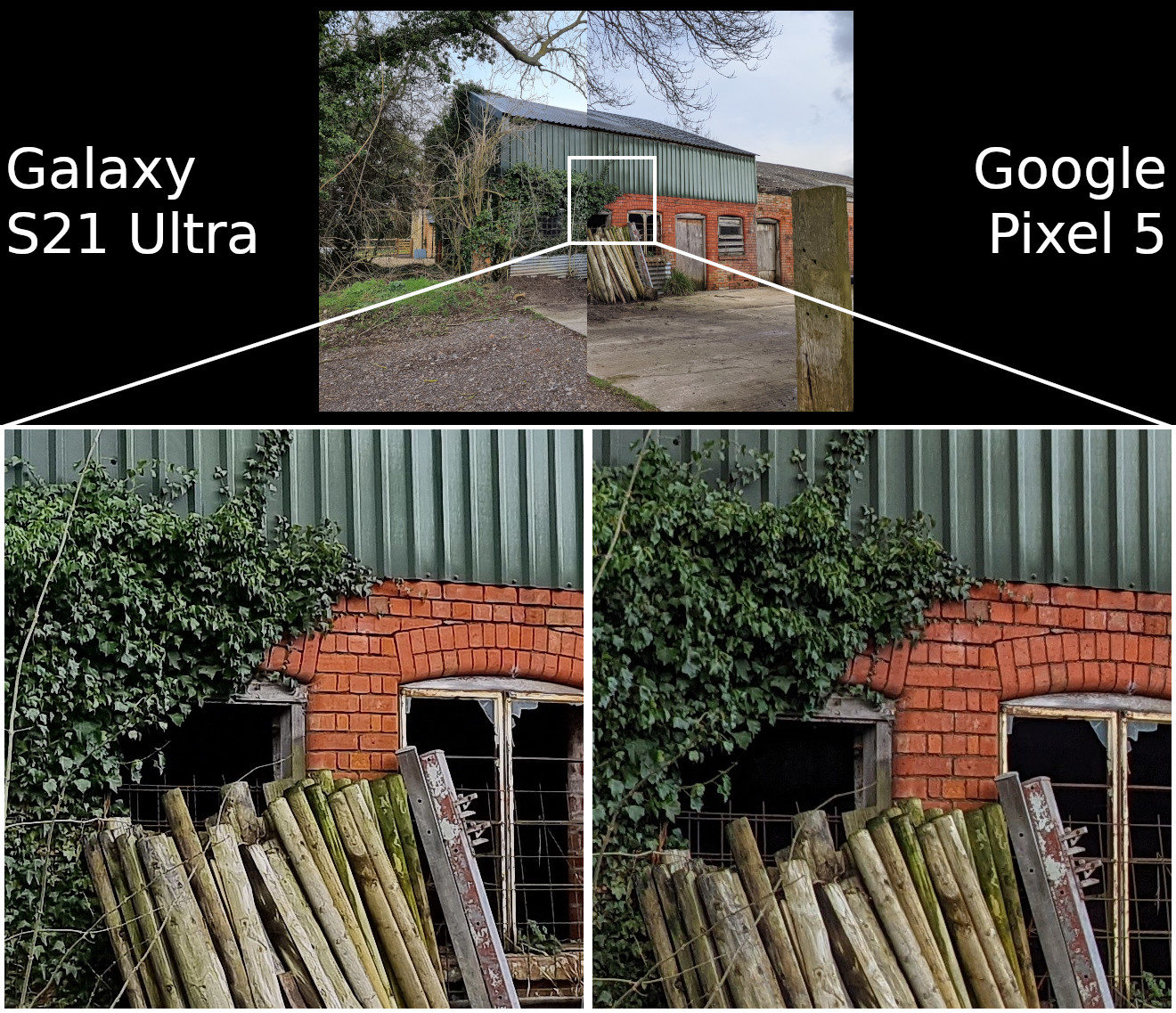
The shot above showcases the similarity you’ll find in details between the two, particularly when looking at reasonably close-by subjects. Samsung’s preference for sharpening leads to more overly bright highlights on the vines but does help the brickwork pop. Heavy post-processing is a case of pros and cons, and Samsung is no exception.
Extreme HDR capabilities
Samsung and Google offer exceedingly powerful HDR capabilities and are two of the best in the business at the moment. Peeking into the highlights and shadows of our samples below reveals a well-balanced dynamic range, mostly absent of clipping, and plenty of detail retention with both handsets.
Related: The best camera phones you can get
Again, the Galaxy S21 Ultra adds a little more saturation and punch to its images, while the Pixel 5 can come out a little darker. However, it’s only on a very close interaction that we can make out a small advantage for the Galaxy S21 Ultra when it comes to HDR capabilities.
Peeking in on the 100% crops reveals a bit of extra noise with the Pixel 5, resulting in a loss of detail in the shadows. The example below highlights this difference as an extreme case. You can also see some green and purple tint on the white walls, where the small image sensor struggles to capture accurate colors in this harshly lit scene. Still, it takes an extreme HDR example to spot these artifacts, and both images come out pretty well.
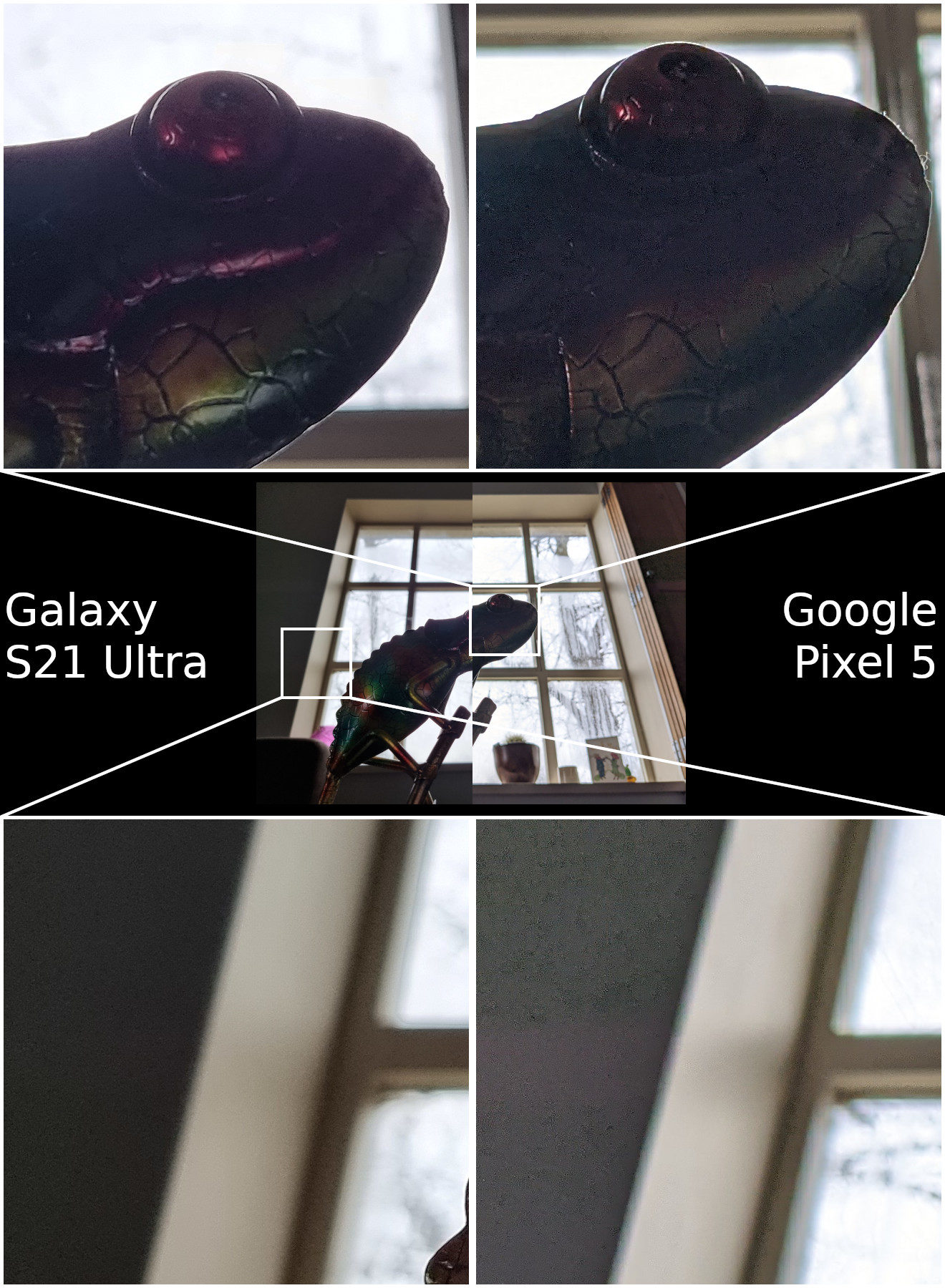
The Samsung Galaxy S21 Ultra ekes out a small advantage in HDR image quality, but this isn’t surprising giving the phone’s larger image sensor. It’s hugely impressive just how close the Pixel 5 comes with a much smaller and older camera setup. Google’s image processing capabilities help the Pixel 5 punch well above its weight here.
Shooting in low light
The same Pixel 5 image sensor hardware limitations from our HDR shots show up again in low light. The example below highlights the light capture differences between the 1/1.33-inch Galaxy S21 Ultra and the 1/2.55-inch Pixel 5 main sensors with Night mode disabled. Samsung has a clear advantage when taking a quick snap in low light, while Google’s flagship is noisy and underexposed.
However, enabling Night Mode closes this gap significantly, with the Pixel 5 providing exposure, colors, and even details to match the Galaxy S21 Ultra. The Pixel 5 is definitely still the noisier of the two, but the Galaxy S21 Ultra is a little too aggressive on the denoise, which smooths out some of its details. An ideal result would probably be right in between the two.
So strong is Google’s faith in its Night processing technology that it markets astrophotography capabilities too. While the result is passable on a dark night, the image is a little noisy. Samsung’s larger sensor again showcases the limitations of Google’s hardware, capturing the light from distant stars that the Pixel 5 can’t make out. Again both are good, but the Samsung Galaxy S21 Ultra is even better.
The Pixel 5 continues to trade blows with the far more expensive Samsung Galaxy S21 Ultra in other low-light shots. Highlights and shadows are just as well balanced, but Samsung clocks in a slightly better dynamic range. Detail-wise, the two are also very close. The Pixel 5 is softer and noisier, while the Galaxy S21 Ultra is heavier on the sharpening pass and can display odd artifacts on texture details.
Related: 6 tips for improving smartphone low light photography
It’s only when we take pictures in almost pitch black that the Pixel 5 struggles to keep up, handing in a blurry, noisy, and unfocused picture in our final example. Just like our HDR showdown, the Pixel 5 comes close to matching the bulk of the Galaxy S21 Ultra’s capabilities at a fraction of the price.
Zooming in on details
We won’t dwell on zoom capabilities too much, as it’s quite clear from the hardware specifications that the Samsung Galaxy S21 Ultra outclasses the Pixel 5 here, which has neither a telephoto nor periscope zoom camera.
At 2x, Google’s Super Res Zoom software actually hands in superior detail versus Samsung’s software zoom technology. However, once Samsung’s telephoto lens kicks in at 3x, the Ultra starts taking a quality lead. Although you’ll be hard-pressed to spot too many major details differences at full-frame. The Pixel 5 holds up reasonably well given its lack of zoom hardware.
At 5x and beyond, the differences become more pronounced, particularly when looking at complex textures like tree lines. The Pixel 5 taps out at 7x zoom while the Galaxy S21 Ultra kicks in its periscope zoom at 10x for a major boost in zoom quality at long range. Samsung boasts up to 100x capabilities, but we wouldn’t recommend taking pictures much beyond 20x, or you’ll notice a major drop off in quality.
Comprehensive, flexible camera packages are expensive, so it’s not surprising to see the Pixel 5 fall short when it comes to long-range photography. That said, Google’s Super Res Zoom technology yields quite good results for short-range zooms, and we’d love to see this paired up with a 3x telephoto lens to offer competitive long-range photography without the expense of Samsung’s dual zoom lens setup.
Wide-angle lenses
The Pixel 5 does feature a wide-angle lens, giving it hardware to match the capabilities of Samsung’s flagship. Its lens doesn’t quite match the extremely wide field of view found on the Galaxy S21 Ultra, but it’s still a notable step back from the main camera that allows you to fit more into your pictures.
Looking at full-frame results, both cameras hand in good-looking wide-angle shots that follow the look of their main cameras. Again, the S21 Ultra offers vivid colors and brighter exposures, while wide-angle images from the Pixel 5 can again look a little washed out and lacking vibrancy.
Neither wide-angle camera captures much in the way of detail. The Pixel 5 is noisier and softer, and appears out of focus at some distances. While Samsung’s processing results in harsher edges and messy textures. But pixel-perfect quality is not really the aim of the game with wide-angle photography.
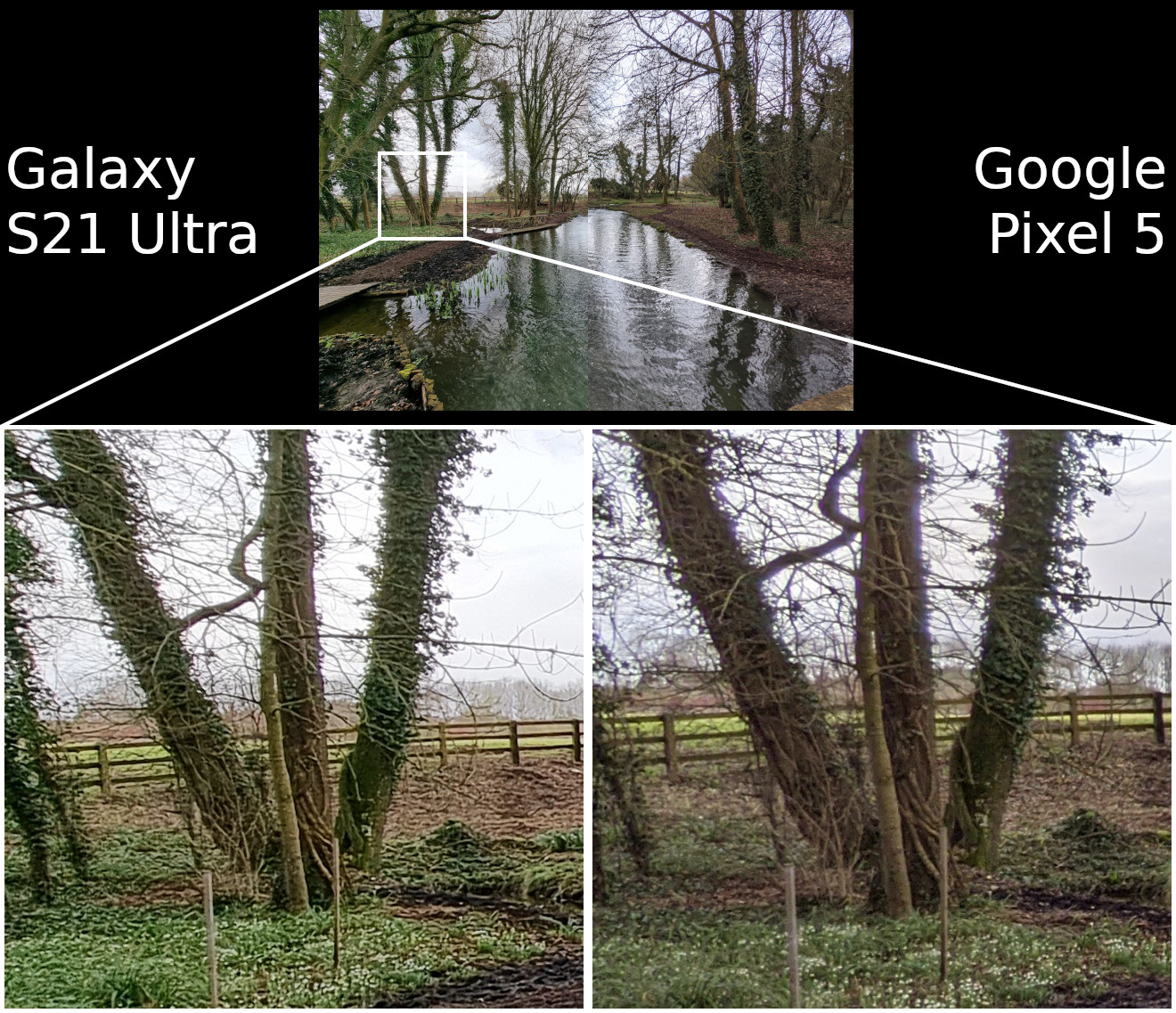
Unfortunately, both wide-angle lenses suffer from chromatic aberration (purple halos) when shooting into a bright light. This effect is more pronounced with the Pixel 5. Edge distortion is similar between phones, with less detail captured at the image edges.
Overall quality boils down to a familiar debate about overzealous post-processing from Samsung and a softer but noisier approach from Google. Google’s approach would probably look better overall. Still, the Pixel 5 cuts corners on a cheaper lens setup and a narrow field of view, which are two important attributes to high-quality wide-angle photography.
Bokeh and portraits
Samsung has another hardware trick to lend it an advantage to portrait shots and bokeh blur — its laser focusing system. With extra depth information at its disposal, the Galaxy S21 Ultra should, in theory, apply its bokeh effect a little more accurately.
This is indeed the case in our first two examples. We can spot edge detection errors with the Pixel 5 in both the flower and figurine examples that don’t appear to the same extent with the Samsung Galaxy S21 Ultra. Otherwise, both phones offer highly accurate colors, exposure, white balance, and blur quality. The images are more alike than one would expect.
The same applies to portrait pictures. The Galaxy S21 Ultra performs better edge detection, particularly when it comes to complex edges like hair and furs. However, Samsung’s implementation isn’t without its faults in these areas. Outdoors, the two offer very similar facial details, skin tones, and textures that are again highly comparable. Although the Pixel 5 is, again, a little noisier.
Indoor lighting reveals a bigger difference between the two, but again you have to look closely at the images to make out the difference. The Pixel 5 suffers from more noise, which eats into the level of detail the phone can capture on face textures and the like. Samsung’s processing is soft and doesn’t produce much more detail, but it’s a marginally better look for portrait shots overall.
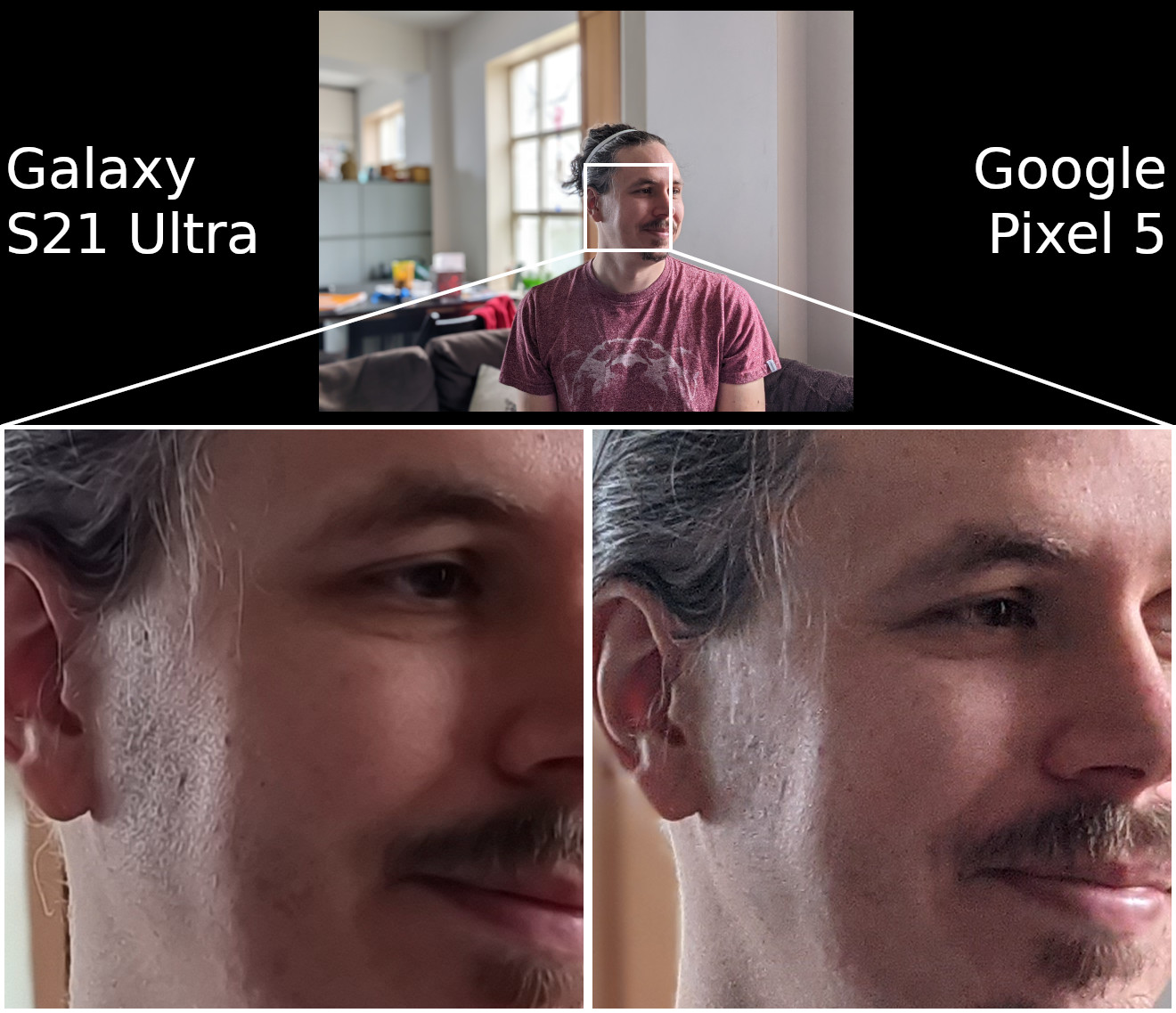
Once again, the results are closer than we might expect, given the price difference between these smartphones. Samsung’s more comprehensive hardware package produces marginally better results, but you have to pixel peek to really notice.
Samsung Galaxy S21 Ultra vs Google Pixel 5 camera test: The verdict
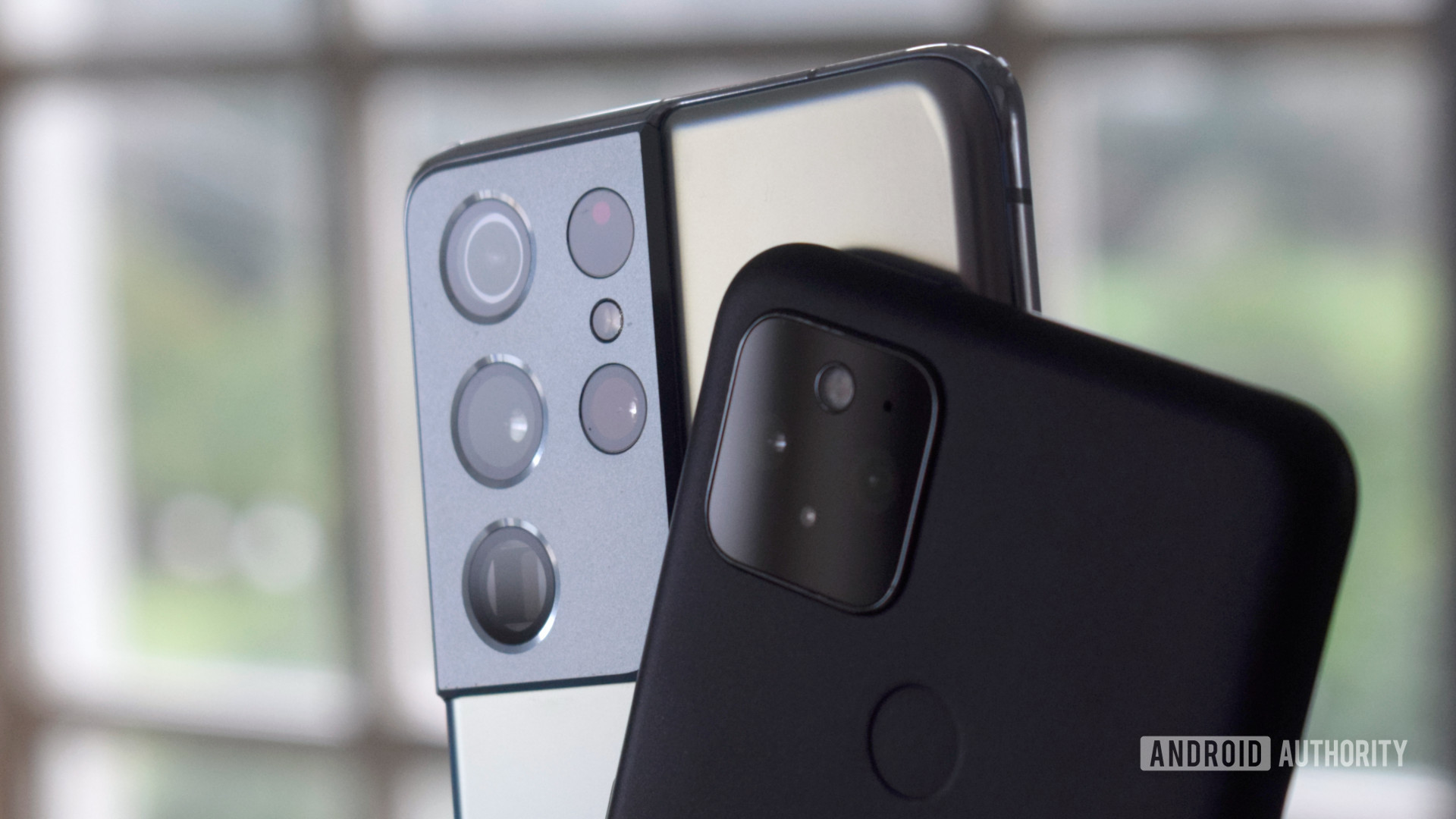
After looking at an extensive range of pictures, it’s clear that the Samsung Galaxy S21 Ultra comes out on top in a few key areas. Its larger image sensor wins out in HDR and low light scenes, particularly when it comes to a quick snap. The comprehensive zoom package also offers quality at a distance that Google’s flagship can’t compete with.
However, the Google Pixel 5 performs equally well in several scenarios, showcasing that computational photography can keep older hardware in the game. General detail is still surprisingly good, and although the phone’s colors can look a little subdued, the Pixel 5 still looks great in daylight and even low light. Providing you have the patience to wait a few seconds for Night mode to do its thing. Its wide-angle camera is also very competitive, despite not offering quite the same extended field of view.
Which phone takes the better pictures?
If you’re in the market for a budget flagship with a solid camera, the Pixel 5 is still one of the best picks in the market. As this shootout has clearly shown. However, the handset’s hardware package isn’t quite in the same league as more expensive flagships on the market. Personally, I’d be very excited to see what the Pixel 6 could do with even just a small update to its camera hardware, as Google’s computational photography capabilities are still some of the best in the business.
What do you think about the Samsung Galaxy S21 Ultra vs Google Pixel 5 camera test? Does Samsung do enough to justify an extra $500 when it comes to photography capabilities?
More Galaxy S21 Ultra camera tests: